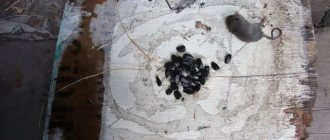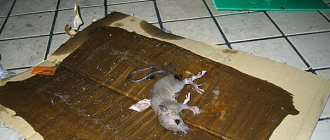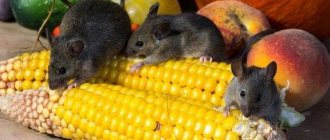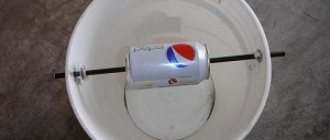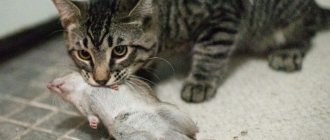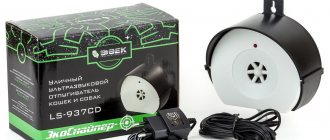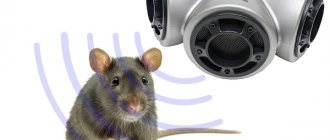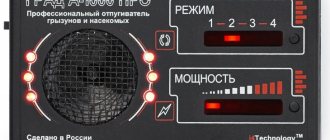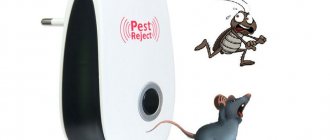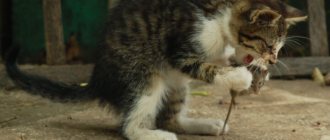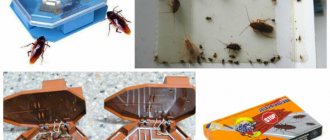How do glue traps work and how effective are they?
The glue trap is a mini-book, which, when opened, will reveal an adhesive composition applied to the “pages of the book.”
The mouse gets stuck in this viscous substance, unable to get out. These devices are absolutely non-toxic and safe for humans and pets.
Let's celebrate! These devices are effective only on mice and young rats, and an adult rat will be able to get out of the “sticky trap.”
Content
- Ready-made option or making your own glue traps
- FOUR ready-made glue trap options
- 1. Glue house traps (from cockroaches, ants and rodents)
- 2. Sticky tapes (from flies)
- 3. Glue trap for garden pests (against aphids and whiteflies)
- 4. Adhesive hunting belts for trees (from ants and wintering insect pests)
Glue traps against insects and rodents are a tape or sheet with a special non-drying glue applied to them. Use a ready-made trap or make it yourself.
The material details: what glue traps are used for, what types of traps there are, what glue is best to use, etc.
Composition and principle of action
The principle of operation of a glue trap for mice and rats is that the glue against rodents needs to be distributed over a small surface of the floor or objects located in places where they accumulate. The animal, running through the sticky trap, will get stuck in the mixture and will not be able to escape from it.
Rat catching glue contains substances such as polybutylene, polyisobutylene and cyclosan. Together they form a viscous mixture that remains sticky for a long time. Thus, not one, but several individuals of mice or rats can fall into a mouse trap at once.
The effectiveness of the glue trap will increase if there is a mouse bait in the middle of the glue coating. This could be a piece of cheese or sausage, bread crumbs, cereal or seeds. Many manufacturers add special aromatic substances to rat glue that attract rodents with their scent. Therefore, it is not necessary to use additional mouse baits.
Application technology
To increase the likelihood of catching small pests, you should apply food to the glued baits: grain or cereal, small pieces of sausage, bacon, etc. Such glue traps help to catch small and medium-sized rodents without any problems.
Important! To catch large rats, you need to secure the glue trap with screws or small nails.
It is better to apply mouse glue with gloves. This is because once it gets on your hands, the removal process is difficult. Ready-made glue traps are placed with bare hands.
Disadvantages of Using Sticky Traps
Like any product, mouse glue is not without its drawbacks in use. Here are the most common:
- Inhumanity. Perhaps this is one of the main negative qualities of this remedy: a slow and cruel death awaits a rodent in a trap. If he is found still alive, then the pest hunter himself will have to suffer, since he will have to think about how to get rid of him. Not everyone is capable of finishing off a helpless little mouse, but throwing it still alive into the garbage chute is no less heartless.
- Allergic activity (hyperallergenicity). There have been cases when substances contained in the glue caused irritation and allergies in people sensitive to them. The sticky trap does not have poison that kills the rat; the rodent dies from exhaustion, which is extremely inhumane
- Extremely difficult to remove glue. Getting glue from sticky traps on children's skin and pet hair is very common. At the same time, it is almost impossible to remove the substance from hair or fur. The only effective way to get rid of matted hairs or hairs is to completely cut off the affected areas. To remove the sticky substance from the skin, you have to use strong chemicals, such as solvent.
- The cry of the victims. Rodents, having fallen into a trap, emit a loud cry for a long time, sometimes a squeal, which is very difficult to hear and sometimes even scary.
The problem of ethics in this case is especially acute. Of course, it is necessary to fight rodents, but if you wish, you can always find a more humane alternative.
Features of the product
The advantage of glue for mice is its absolute safety. Since the composition does not contain toxic substances, it is used in the food industry and in children's educational institutions. The only problem that someone who uses such a tool may encounter is cleaning the glue. This is because the product is designed to catch large fish, so it has a thick, sticky consistency that is not easy to remove, especially from fabric and furniture.
The second important advantage is the complete absence of odor. Even if the traps are placed in areas with high temperatures, they will not produce a foul odor or cause respiratory irritation.
When purchasing rodent control products, consumers pay attention to the image of the manufacturers. Trust plays a major role.
Important! Glue that is too liquid is unable to stop even small rodents, and glue that is too thick is difficult to squeeze out of the tube.
Rules for using the adhesive composition
Using the substance is not difficult; you can carry out the process yourself. To do this, you must follow the instructions:
- Take a piece of smooth and flat material - cardboard or plastic - no smaller than 10x10 cm for mice and 25x20 for rats. For the latter, it is additionally advisable to attach the selected material to the floor using self-tapping screws, otherwise the animal may drag the entire trap with it and stain the room with an adhesive substance. A cardboard sheet is perfect for applying the adhesive composition.
- When fighting mice, you should lubricate the substrate with glue in strips 1-2 cm wide, maintaining a distance between them of up to 4-5 cm.
- To catch rats, stripes are drawn wider and at a greater distance. The substance acquires irreversible stickiness half an hour after application.
- It is recommended to place bait in the middle of the trap, for example bread soaked in vegetable oil.
Rat traps should be placed in places where victims are more likely to appear - in corners, next to walls and partitions, directly next to burrows, at a distance of 3 to 15 m from each other, based on the volume of the room, its clutter with furniture and the number of pests .
For maximum effectiveness of a glue trap for rats, you need to place it in places where rodents are often found.
At the same time, it is necessary to ensure isolation from children and animals and minimize contamination of the sticky surface; therefore, it is safer to place traps under furniture, inclined towards walls or in special bait houses.
Glue traps must be inspected frequently to see if new animals have been caught and, if this happens, replaced with fresh ones.
If the trap is used for rats, then it is enough to examine it once a day. This is explained by the fact that the caught animal will emit danger signals (squeaking), which is why its fellow tribesmen will avoid this place. But when mice are caught using glue, this factor turns out to be insignificant - these rodents easily run into the trap in a group in a short period of time. Mice are much less cautious animals than their larger relatives; therefore, several victims often fall into one trap at a time.
What to do with caught victims
When adhesive users first turn to this method of catching pests, they often have the question of what to do with the caught rodents. The choice of the most appropriate option from an ethical point of view remains up to the hunter himself . There is only one piece of advice that will allow you to deal extremely humanely with a captured animal. To alleviate his suffering, you can generously wet a piece of cloth with gasoline or acetone and place it on top of the caught victim. She will first lose consciousness, and after that, being in an unconscious state, she will suffocate.
To make it easier for a rodent to die in a glue trap, cover it with a piece of cloth soaked in gasoline or acetone.
Few are ready for such actions. Traps are most often simply thrown into the garbage chute with mice still alive, leaving them in a painful and hopeless situation.
There is an opinion that the substance in the trap gradually dries out, but this is not the case. Due to its special composition, it retains its effectiveness until its layer becomes dirty with dust, sand from the street, flour or dirt. For this reason, it is advisable to change the substrate with the substance approximately every 6-7 days.
Types of glue traps against mice and rats
There are a lot of adhesive sticky “traps” on sale and the difference between them is mainly in shape or size. Conducted sociological surveys made it possible to identify the most popular adhesive traps from the total number of adhesive traps on the market.
CatchExpert
- The adhesive plates produced by an Argentine company are shaped like a book and measure 17 by 25 centimeters.
- The adhesive viscous composition applied to the cardboard base has the property of not drying out for a long time, thanks to special additives.
- The glue applied to the surface always has a protective layer and it will need to be removed before placing sticky devices.
Rodentoff
Under the Gryzunoff brand you can find various variations of adhesive devices. They can be in the form of sheets, plastic trays or prefabricated cardboard houses.
There are universal Velcro strips on sale that can catch both mice and rats. But there are also targeted trapping devices - specifically from rats and specifically from mice.
Any version of the Gryzunoff sticky trap has the same technical characteristics.
The adhesive base is created using:
- mineral oil;
- rubber;
- rosin;
- special fragrances - attractants.
Thanks to the fragrances, there is no need to place additional bait on the sticky surface.
Note! Thanks to the components of the adhesive composition, it has the ability not to harden for more than a hundred days, which increases the efficiency of using these devices.
Trap
- The Kapkan glue trap is a universal means for catching rodents.
- The possibility of using these “traps” is quite wide, including places where the use of chemical rodenticides is absolutely not possible.
- The adhesive layer of the trap is made of rubber and plant resin, which attract rodents with their aroma.
- These strips have a fairly thin layer of cardboard under an adhesive backing. This is done so that the installed “trap” does not stand out too much from the surface on which it will be located.
Glue "Clean House"
Glue Clean house from rodents and insects is a popular substance that can be used in different rooms.
The composition is a mixture of three components:
- Polybutylene – 76.6%.
- Cyclocaniol – 10.9%.
- Polyisobutylene – 12.4%.
It has several main advantages:
- Does not freeze for a long time.
- High viscosity, adhesion.
- Does not deteriorate with prolonged exposure to moisture.
- Safe glue for pets and people.
- Low cost.
Efficiency is increased by adding bread, cheese, and cereal to the sticky layer.
Forsyth
An effective trap that differs from other names. Its peculiarity is that it has a specific smell that attracts rodents. During operation, the room temperature cannot be increased above +30 degrees. Used to combat small animals and insects. It does not emit harmful substances, which is why it is used in hospitals, educational institutions, and food storage warehouses.
MR mouse
There is also a name for a special glue that is packaged in tubes. The finished trap is a plate measuring 20x15 cm. It can be effectively used against mice, rats, and insects. It does not contain harmful substances, so the device is considered safe for the human body and pets.
Block
Devices used to catch mice, rats, insects. The record must be removed from the packaging, the protective film removed, and placed in a pre-designated place. The temperature range that the sticky surface can withstand is from +5 to +50 degrees. Using bait you can increase the effectiveness of the trap.
Kotofey
If all previous adhesive devices are disposable, then the Kotofey sticky traps are reusable.
To do this, the kit includes ten adhesive layers, a plywood plate and special clamps for fastening.
The sticky layer is placed on a plywood board using clamps and after a rodent gets on it, it is simply unhooked and disposed of.
The adhesive base is based on:
- polybutylene;
- polyisobutylene.
Good to know! The adhesive composition does not contain any chemical components, which indicates the safety of using this device in human and domestic animal habitats.
Mr. MOUSE
These traps are made in several types:
- in the shape of a house;
- in the form of plates.
Any chosen form is convenient to use - just remove the protective layer and place the trap in places where “gray robbers” are likely to appear.
The adhesive composition does not contain chemical compounds, which allows the plates to be placed in food storage areas.
How to wash glue for rodents
After using glue traps, any glue remaining on the surface can be washed off with alcohol, acetone or any alcohol-containing product.
If glue gets on your hands, a rich hand cream will help you wipe it off.
It is extremely difficult to remove glue from textiles. It is possible to clean the fabric only by resorting to a strong agent, which, obviously, will cause irreparable harm to it. You can turn to professional dry cleaners, but there is no guarantee that they will be able to remove the adhesive stain from the fabric without leaving a trace.
Sometimes situations arise where pets get into the glue. It is easier to cut off a glued piece of fur on a long-haired pet. But when your pet has short fur or you have an expensive haircut that you would hate to spoil, then you need to thoroughly rub the area stained with glue with a cotton swab dipped in vegetable oil. Then use any detergent to wash the area of wool. For complete cleansing, these activities will have to be done many times.
Mice and rat glue is an affordable, simple and reliable means of exterminating household pests. It will help you quickly get rid of their unwanted intrusion.
Safety precautions
Despite the fact that mouse glue does not emit toxins or poisons, you should adhere to some safety measures:
- Wear disposable rubber gloves before applying the product.
- Apply glue to the base using a brush or sponge. You can't do this with your hands!
- Remember that glue traps should be kept out of the reach of children and pets. If possible, completely limit entry into the room until the pest is caught.
- After all manipulations, you must wash your hands with soap and running water.
- If glue does get on your skin, you can wash it off with acetone or special gasoline. After finishing work, be sure to wash your hands thoroughly with soap. If the product gets on your hair or fur, it is extremely difficult to wash it off and most often you have to remove the contaminated area with scissors.
Advantages and disadvantages
Like all disinfestation tools, mouse glue has both positive and negative sides.
The undoubted advantages of anti-rat glue are:
- ease of use;
- long period of validity;
- no odor;
- absence of toxic fumes;
- low cost.
The disadvantages of glue traps for rats include the following factors:
- if handled carelessly, anti-mouse glue can get on your hands and floor, and it is difficult to remove;
For more information on how to remove glue from mice, read our article: How to quickly remove glue from mice.
- you may find the victim still alive and squeaking loudly;
- A pet may get caught in the trap.
Large pets, such as dogs and cats, will have to have their fur and glue cut off, while small pets, such as guinea pigs and hamsters, may die.
DIY mouse glue
There is also a recipe for making mouse glue with your own hands. To do this you will need rosin, petroleum jelly, pine resin, and bitumen pitch. But since making glue for mice with your own hands is not so easy, it is easier to purchase a ready-made product in a store. Moreover, the average price of products is in the range of 150-300 rubles. Traps will cost a little more, with the price scale directly proportional to the complexity of the design.
Glue for rodents is effective and safe . But sometimes, even despite the powerful composition of the product, it is not possible to catch the mouse. It is worth trying a different drug or choosing a more humane method of bullying. For granaries it is easier to purchase special poison or mousetraps.
In a house where there are children, it is better to have a cat. If you don’t want to kill rodents, but just need to scare them away, then use ultrasonic devices that emit sounds that can only be heard by animals.
Popular brands of sticky anti-mouse compounds
There is a large amount of such Russian-made glue on the market at a fairly low price. Most often, the product is packaged in an aluminum tube, but you can also find ready-made cardboard products, which, however, are much more expensive. The composition and principle of operation are the same for all, and therefore they are equal in efficiency.
The most popular and most common brands:
- "Alt".
- "Kotofey"
- "Clean house".
- "Foresight".
- "RaTrap".
- "Trap".
How to replace mouse glue
In some situations, the use of glue is impossible or ineffective. In this case, there are several alternative options:
- You can use a traditional mousetrap. The rodent will be killed without your assistance. All you have to do is throw it away.
- Mummifying poison. Quite a convenient way to fight rats. But then the dead rat or mouse will lie under the furniture, where you will not be able to see or reach it.
- Loose poison. This type of poison is suitable only in rooms where there are no other inhabitants. The bright color of the drug can attract a child or pet. In addition, a cat or dog can eat a poisoned rodent.
- Ratcatcher cat. A rather unusual method of controlling rodents, but very effective.
- Ultrasonic repeller. The most modern method. It is based on the fact that a device inserted into a socket emits a sound that cannot be heard by humans, but cannot be tolerated by mice and rats. They just run away.
Features of glue for rodents
The drug does not have a strong odor, there are no toxic substances in its composition, so it is completely harmless to people and comfortable to use. The adhesive may contain active ingredients: cycloisan, as well as polyisobutylene or polybutylene.
The penetration of these substances into the body in minimal quantities will not lead to poisoning. However, for preventive purposes in these circumstances, it is recommended to perform gastric lavage and seek specialized help from a doctor.
The procedure for using mouse glue directly depends on the form of its release. And it is produced in two versions:
- The finished trap is a cardboard base on which a layer of adhesive has already been applied. It is easy to use, you just need to remove it from the packaging and place it where necessary. The cardboard trap is impregnated with a special substance whose aroma is attractive to mice. The animals themselves come running to this smell and stick to the cardboard;
- the liquid suspension is packaged in hermetically sealed bottles or tubes. This product can be applied to various washable substrates (glass, ceramics, plastic, etc.). It is recommended that you first test in a small area how the suspension will wash off the surface. And if you have no intention of experimenting, you can apply mouse glue to a piece of cardboard or plywood, which you can throw away after use.
Before using glue against rodents, you should read the manufacturer's instructions, since each drug has its own characteristics and requires certain conditions for its use.
Alternative to glue and cool traps
There are a number of alternative options that can replace anti-mouse glue. They have their own characteristics, which leads to changes in operating rules.
These include:
- Classic mousetraps. The death of a rodent occurs almost instantly. It is important to choose the right bait, choose a place to install the device and not leave your own odors. Rodents can successfully bypass them due to non-compliance with clear installation rules.
- Poison. It can only be used in rooms where there are no people or pets. Prohibited for use in hospitals and food storage warehouses. Poisoned mice and rats come out of hiding. But some of them die in hard-to-reach places, decomposing in the process. On sale you can find a poison that mummifies the carcasses of animals, thereby eliminating the persistent, unpleasant odor.
- Ultrasonic repeller. It is a compact device that connects to a common network. Creates ultrasonic waves that are inaudible to humans. Rodents are frightened by this sound. They begin to avoid the room where the device is operating. However, over time, mice can become accustomed to ultrasound. As a rule, rats are repelled by signals with a frequency of 20-50 kHz, mice by 10-20 kHz.
Many owners of private houses or apartments get a cat. This pet will not only create a more comfortable environment and delight others, but will also prevent mice from appearing. But in this case, the feline family is likely to catch some kind of infection or even get poisoned through a poisoned rodent carcass, which happens to almost all animals.
What to choose: glue or ready-made traps?
First you need to understand the question, how does mouse glue work? The whole secret lies in a specially developed substance that does not dry out over time and has such strong properties that the mouse sticks to it in an instant. The animal rests with its other paw, but it also sticks tightly. Often the rat sticks with its entire body and is completely immobilized.
There are two forms of the product: glue and ready-made traps. The first option looks like a tube with a product that needs to be applied to cardboard, a board or other surface. The trap looks like a ready-to-use plate with glue already applied at the factory, which is covered with a protective film on top. The first option is cheaper, but it makes sense to purchase it only when producing a large number of devices.
The rodent dies not from the very fact of sticking, but more often from hunger and thirst. This will take several days. So if a person finds an animal stuck to a mouse trap, the mouse will need to be killed, thrown into the trash, or disposed of in some way. Remember that a corpse smells extremely unpleasant, so you need to throw it away while it’s still alive. Actually, these are all the rules regarding how to use mouse glue.
